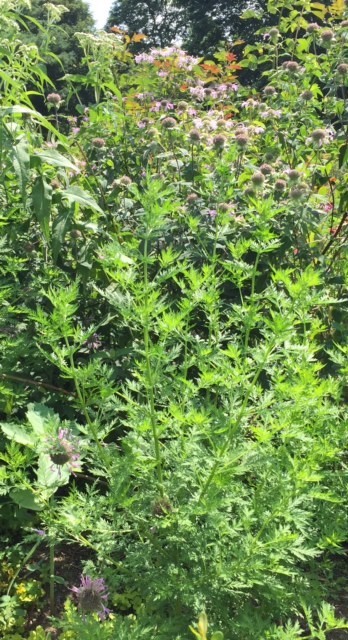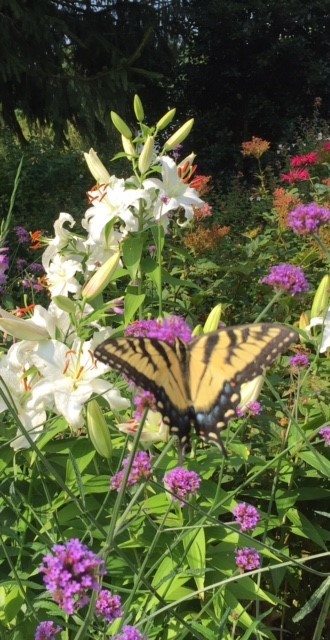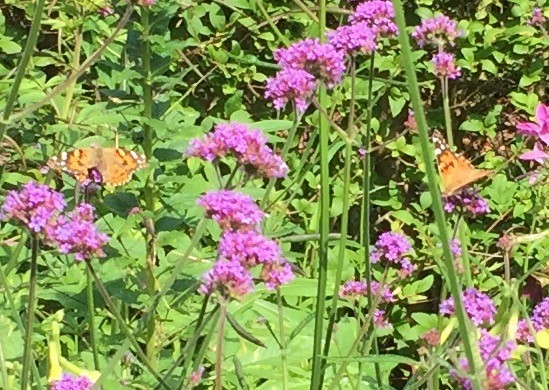Blog
A Note from Rick | Valuing our Native & Non-Native Plants
By Rick Bogusch
The Glorious August Garden... Come Visit!
Bridge Gardens was created 30 years ago when Harry Neyens and Jim Kilpatric planted a combination of native and non-native species throughout the 5-acre grounds. We continue to honor their design by valuing both native and non-native species.
One of my favorite natives, in bloom right now, is swamp rosemallow, or Hibiscus moscheutos. Though it’s usually found in swamps and wetlands, it is quite comfortable in one of our shrub beds. Its habit is also shrub-like and needs space, growing 4-5 feet tall and 3-4 feet wide. Once it starts blooming, it continues for at least a month. It’s a favorite of pollinators like bumble bees and small wasps alike. Here it is growing with another native, Indian grass or Sorghastrum nutans.
Another favorite plant is tall verbena, or Verbena bonariensis. This plant is not native - it’s from Argentina - but offers a favorite food source for all butterflies, including swallowtails and monarchs. A self-sowing annual, it really makes an architectural statement with its slender, upright stems that do not need staking.
The stems branch at the top and are crowned with clusters of long-lasting lilac purple flowers. Even though its tall at 4 feet or more, its a great see-through plant, and is actually suitable for the front of the border or anywhere you like.
All of the plants in our 4-quadrant herb garden have a reason for being there, besides being attractive and garden-worthy. That is especially true of plants in the medicinal bed.
Shown here is sweet Annie wormwood, Artemisia annua. This nondescript, fern-like plant is highly aromatic and is commonly grown to harvest for scented wreaths and dried floral arrangements. It’s an easy-to-grow annual and often tops out at 3 to 4 feet in height! What is interesting about this plant is that it is an antimalarial herb that has become the last line of defense where the malarial parasite has become resistant to other drugs. Though it has been grown in China for thousands of years, it’s development as an antimalarial drug is quite recent and the scientists who discovered this important medicinal property were awarded a Nobel prize in 2015.



So what should you be doing now?
- If you haven’t planted fall crops in your vegetable garden, its not too late
for beets and carrots, but you’d better do it right away. Some garden centers have seedlings of broccoli and cauliflower - you could give those a try. Also, make sure that you have seeds of lettuce, spinach, arugula, kale, and other greens as those can be started now or over the next couple of weeks and enjoyed well into the fall. Keep up with your harvests of tomatoes, eggplants and peppers and enjoy the bounty of late summer!
- How is your lawn looking? Summer heat and humidity can wreak havoc on the lawn. Now is the best time to assess lawn needs and make your plan for managing them going into the autumn season.
Did you know that September is one of the best months to renovate or install a new lawn and repair and treat your existing lawn? Paul Wagner, of Greener Pastures Organics, our lawn expert, will be discussing lawn renovation strategies during his Tuesday, August 22 free lawn expert day right here at Bridge Gardens! And Paul leads the last in our Organic Lawn Care series, Step #3 on September 16.
All of Paul’s programs at Bridge Gardens are presented in partnership with Perfect Earth Project.

